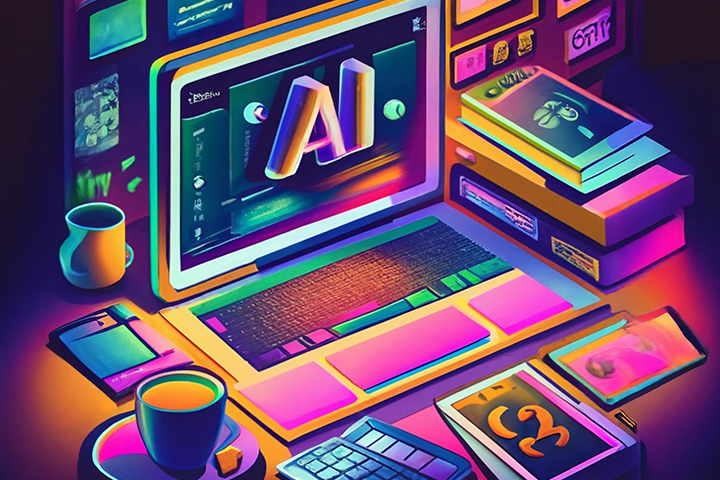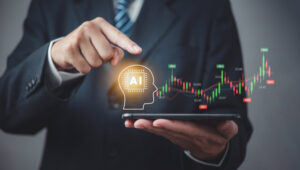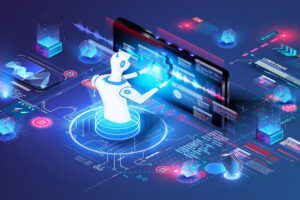As we step into a world increasingly driven by technology, the Future of AI in graphic design emerges as a fascinating frontier. With the rapid evolution of artificial intelligence, the realm of graphic design is poised for transformative changes that will redefine creativity and innovation. This article explores the multifaceted impact of AI on graphic design, offering insights into how this technology is shaping the future of visual communication.

Understanding the Basics of AI in Graphic Design
At its core, artificial intelligence refers to the simulation of human intelligence in machines. In the context of graphic design, AI encompasses algorithms and tools that assist designers in creating, editing, and enhancing visual content. The integration of AI into graphic design is not just a trend; it’s a revolution that promises to enhance creativity and efficiency.
The Role of AI in Enhancing Creativity
One of the most significant impacts of AI in graphic design is its ability to enhance creativity. By automating repetitive tasks and providing intelligent design suggestions, AI allows designers to focus more on conceptualizing and innovating. Tools like Simplified offer AI-driven solutions that streamline the design process, enabling designers to explore new creative horizons.
AI-Powered Design Tools and Software
The advent of AI-powered design tools has revolutionized the way designers work. Software such as Adobe Photoshop and Illustrator now incorporate AI features that assist with tasks like image recognition, background removal, and color correction. These tools not only save time but also enhance the quality of the final product.
The Impact on Job Roles and Opportunities
While some fear that AI may replace human designers, the reality is that AI is more likely to augment human capabilities rather than replace them. AI can handle mundane tasks, allowing designers to focus on more complex and creative aspects of their work. This shift opens up new opportunities for designers to evolve in their roles and explore innovative design possibilities.
Challenges and Ethical Considerations
Despite the numerous benefits, the integration of AI in graphic design also presents challenges and ethical considerations. Issues such as copyright infringement, data privacy, and the potential for AI-generated content to mislead or deceive audiences need to be addressed. Designers and developers must work together to establish ethical guidelines and ensure responsible use of AI technologies.
Impact on the Design Process
AI is reshaping the traditional design process by introducing new methodologies and approaches. From ideation to execution, AI tools offer valuable insights and suggestions that enhance the overall design workflow. This transformation is evident in various applications, such as AI-generated design ideas, which provide designers with fresh perspectives and inspiration.
The Future of Human-AI Collaboration
The future of graphic design lies in the collaboration between humans and AI. As AI continues to evolve, designers will need to adapt and learn how to leverage this technology effectively. By embracing AI as a creative partner, designers can unlock new levels of innovation and elevate their work to unprecedented heights.
AI and Personalization in Design
AI’s ability to analyze vast amounts of data allows for highly personalized design experiences. By understanding user preferences and behaviors, AI can tailor design elements to suit individual needs and preferences. This level of personalization enhances user engagement and satisfaction, making designs more impactful and meaningful.
Preparing for the Future: Education and Skill Development
To thrive in the AI-driven landscape of graphic design, designers must invest in education and skill development. Learning how to use AI tools and understanding their capabilities will be crucial for staying competitive in the industry. Online platforms and courses offer valuable resources for designers looking to expand their knowledge and expertise in AI technologies.
AI and the Democratization of Design
AI is democratizing the field of graphic design by making advanced design tools accessible to a wider audience. Individuals with little to no design experience can now create professional-quality designs using AI-powered platforms. This democratization is fostering a new wave of creativity and innovation, as more people can participate in the design process.
The Role of AI in Sustainable Design Practices
Sustainability is a growing concern in the design industry, and AI is playing a pivotal role in promoting sustainable design practices. By optimizing resource usage and reducing waste, AI-powered design tools contribute to more environmentally friendly design solutions. This shift towards sustainability aligns with the broader global movement towards a more sustainable future.
AI and the Evolution of Design Trends
AI is influencing the evolution of design trends by providing insights into consumer preferences and emerging styles. By analyzing data from various sources, AI can predict trends and offer designers valuable guidance on what will resonate with audiences. This predictive capability enables designers to stay ahead of the curve and create designs that are both relevant and impactful.
Conclusion: Embracing the Future of AI in Graphic Design
The Future of AI in graphic design is bright and full of possibilities. As AI continues to evolve and integrate into the design process, it will undoubtedly shape the industry in new and exciting ways. By embracing AI as a valuable tool and creative partner, designers can unlock their full potential and create designs that inspire and captivate audiences around the world.

FAQs
What is the role of AI in graphic design?
AI plays a crucial role in graphic design by automating repetitive tasks, enhancing creativity, and offering intelligent design suggestions. It helps designers focus more on conceptualizing and innovating.
Can AI replace human designers?
While AI can handle mundane tasks, it is more likely to augment human capabilities rather than replace them. AI acts as a creative partner, allowing designers to focus on more complex and creative aspects of their work.
How can designers prepare for the AI-driven future?
Designers can prepare for the AI-driven future by investing in education and skill development. Learning how to use AI tools and understanding their capabilities is crucial for staying competitive in the industry.







